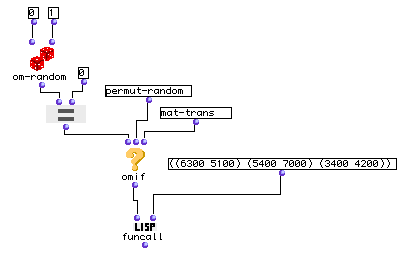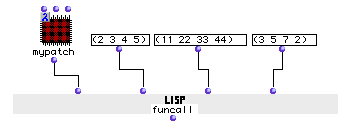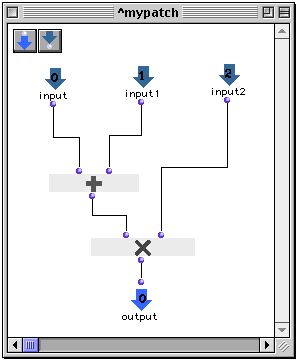OpenMusic Reference
funcall

funcall
(LISP function) -- returns the result of the evaluation of function
Syntax
funcall function &restarguments
Inputs
| name | data type(s) | comments |
|---|---|---|
| function | symbol, function name or lambda function | the function that will be evaulated |
| arguments | any | repeatable; data is passed to function as arguments |
Output
| output | data type(s) | comments |
|---|---|---|
| first | any | the result of the evaluation |
Description
Calls function , passing it arguments as inputs, in the order entered. It is as if the arguments of funcall were plugged in, left to right, to function . The result, is returned.
function may be a symbol, a function name, or function in lambda mode. Note that if you pass a function in lambda mode with repeatable inputs, you must add the correct number to accomodate the number of arguments you are passing it at the other inputs. This is not necessary if the function name is entered directly instead of its icon in lambda mode.
funcall is similar to apply in operation. The difference is that funcall passes all of its inputs as single arguments, where apply treats the last input specially, passing its elements individually to function .
funcall only calls function once. If you need to call a function multiple times to process data in a list or lists, consider using mapcar or mapcan .
 |
LISP functions |
|---|---|
The basic LISP functions are too numerous to document comprehensively in this manual. As an aid to the neophyte, the most commonly used have been included in this documentation, but they represent a small fraction of the total functionality of the MCL environment. Numerous on-line resources exist, for instance the online version of Common Lisp the Language, 2nd Edition.
Examples
Using funcall to transform chords

Here funcall is used in conjunction with a random element to transform pitch material. Our pitch material is six pitches, grouped into three groups of two pitches each. This is the data that will be passed to whichever function is chosen by the omif module, which will choose one or the other based on the results of the ‘random’ number generated by om-random. If it is 0 then the first function, permut-random will be selected. If it is one, the second, mat-trans will be passed to funcall . The result is plugged into a Chord-seq object and visualized as musical notation.
permut-random will randomly re-order the groups of two; this will result in a change in the order of the two-note chords. mat-trans will recombine the three groups of two into two groups of three. The result will be two three- note chords instead of 3 pairs of notes.
Two possible outcomes are shown below, the first being the result of the mat- trans , the second of permut-random .

Using a lambda patch to combine multiple functions with funcall

These three lists will be passed as inputs 1, 2 and 3 to the patch mypatch in lambda mode. The inside of mypatch looks like this:

The elements of lists one and two will be paired off and added, and the elements of the resulting list will be paired off and multiplied by the elements of list three. The result returned by this function call is:
? OM->(39 125 259 98)
| Prev | Home | Next |
|---|---|---|
| floor | Up | geometric-ser |